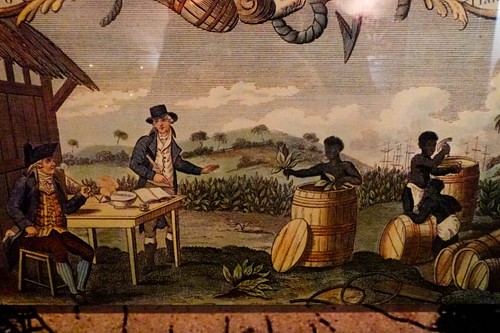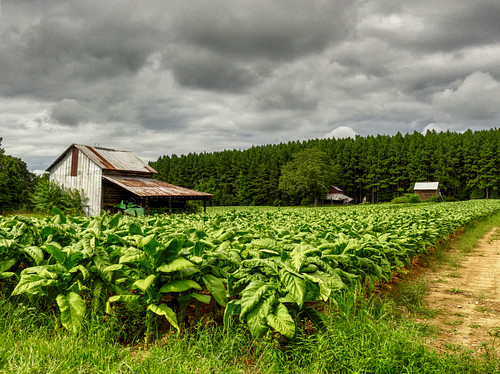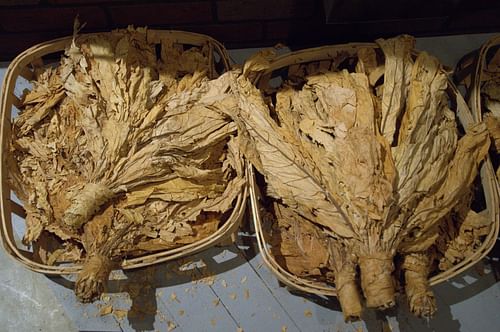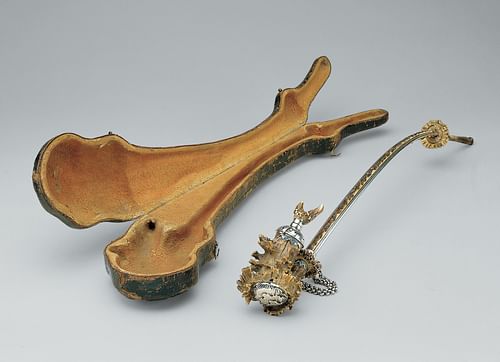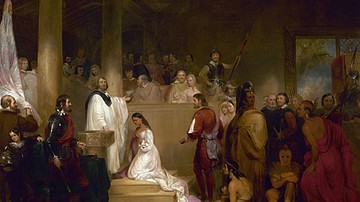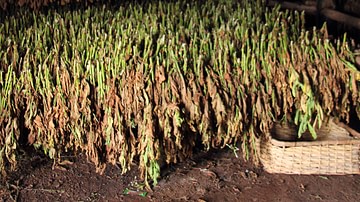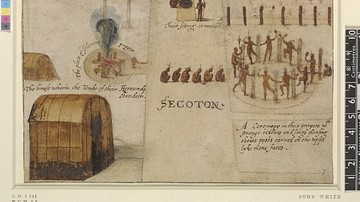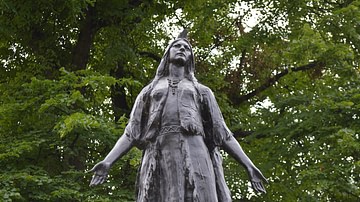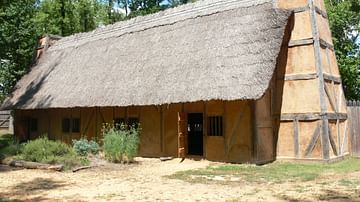The most important cash crop in Colonial America was tobacco, first cultivated by the English at their Jamestown Colony of Virginia in 1610 CE by the merchant John Rolfe (l. 1585-1622 CE). Tobacco grew in the wild prior to this time and was cultivated by the indigenous peoples as a stimulant but, after Rolfe, became the most lucrative crop in the Americas.
The indigenous people regarded tobacco as a sacred plant which allowed access to the spirit world, a stimulant, and a medicinal substance. After the Spanish colonized the West Indies, South and Central America after 1492 CE, tobacco was grown, harvested, and exported as a recreational drug, and its popularity in Europe and elsewhere made it highly profitable.
Once the English had established themselves at Jamestown, this model repeated itself and Virginian tobacco became so popular that, by 1627 CE, 500,000 pounds of tobacco a year were shipped from the colony to Britain. As British colonialism in North America expanded, so did the tobacco plantations and, in time, tobacco served not only as the economic foundation of the colonies but as currency. The process of growing and selling tobacco moved through a series of steps which included the farmer receiving a tobacco note (a kind of check) in return for his product with which he could purchase goods. The tobacco was shipped to English merchants who would send back more goods in payment.
This process was observed on a constant basis and the colonies flourished further after the Maryland and Carolina colonies were established and their plantations began to produce more tobacco. As tobacco was a labor-intensive crop, it encouraged the slave trade as well as clearing large tracts of land formerly occupied by indigenous nations. Tobacco, and the economic system of mercantilism, factored into the grievances of the colonists leading to the American Revolutionary War (1775-1783 CE) and continued to exert a powerful hold over the economy once the United States of America was established.
Jamestown & Tobacco
England established its colony at Jamestown in 1607 CE, and at first, it seemed as doomed as earlier English colonies such as the Roanoke Colony (1587-1590 CE) and the Popham Colony (1607-1608 CE). Many of the initial Jamestown colonists were upper-class Englishmen who had no prior experience in any kind of productive labor and others seem to have been simply lazy or inept. Captain John Smith (l. 1580-1631 CE) took command of the colony and kept it going until he left for England in October 1609 CE following an accident. Between the fall of 1609 CE and May 1610 CE, the colonists suffered, starved, and many died. Jamestown lost at least 80% of its population between 1607-1610 CE.
In May of 1610 CE, John Rolfe arrived along with Sir Thomas Gates (l. c. 1585-1622 CE) and, shortly afterwards, Thomas West, Lord De La Warr (l. 1577-1618 CE) arrived on another ship. Gates and De La Warr organized the colony while Rolfe busied himself with planting the crop that would not only save it but become the economic foundation of Colonial America: tobacco. The Spanish had cultivated the naturally growing plant known as Nicotiana tabacum and their blend was a closely guarded secret as they had a monopoly on the American tobacco trade. Rolfe had managed to get hold of some of their hybrid seeds which he thought would do well in the marshy soil of Virginia. He was right, and by 1614 CE, he was a wealthy man and the colony was flourishing.
Tobacco & Slavery
Work on tobacco plantations was at first carried out by indentured servants. These were men and women who had agreed to work for a master for seven years in return for passage to North America and a grant of land once they had completed their service. In 1619 CE, the first Africans arrived in Jamestown via a Dutch ship and, although frequently referred to as slaves, seem at first to have been treated in the same way as indentured servants. Scholar David A Price notes:
Although it is tempting to assume that these first recorded Africans in English America were also the first slaves, there is evidence to suggest they were not. They may instead have had the legal position of indentured servants, like many of the white newcomers, eligible for freedom after completing a period of service. (197)
Black and white servants worked the tobacco plantations and, on smaller farms, in the company of the landowner and his family. The relationship between the white English landowners, white servants, African servants, and the local indigenous people of the Powhatan Confederacy was never one of equality but grew strained and far more unequal as more land was required by the colonists for settlements and tobacco plantations which encouraged not only the displacement of Native Americans but the development of the slave trade which brought more free labor.
In 1640 CE, a black indentured servant named John Punch left his master’s service, citing harsh treatment, before he had fulfilled his contract, and two white indentured servants left with him. When they were caught and returned to their master, the white servants only had four years added to their time; Punch was sentenced to servitude for life. After 1640 CE, relations between blacks and whites increasingly changed as white servants received better treatment.
In this same way, the Powhatan Wars (1610-1646 CE), altered relations between the colonists and indigenous people. The wars cleared the land for colonization and cultivation and also provided the English with slaves for their fields. The Powhatans had never fully welcomed the English but, during John Smith’s time, agreed to a peace which ended in 1610 CE. John Rolfe reestablished good relations with the natives by marrying the famous Pocahontas (l. c. 1596-1617 CE) in 1614 CE, but when she died in 1617 CE, tensions again mounted and a second war broke out in 1622 CE. By the time the third war was over, the power of the Powhatan Confederacy had been broken and many of the natives enslaved.
The colonists found that these people were not as well suited to hours of constant labor as those imported from Africa and so the slave trade grew and slavery was institutionalized in Virginia by 1661 CE and strengthened by a series of laws passed throughout the 1660s CE. Maryland Colony had been established in 1632 CE and the Carolina Colony (later North and South Carolina) in 1663 CE, both large producers of tobacco. By 1700 CE, all three of these states were exporting their product to London and were flourishing. The economy was boosted further by the sale of Native Americans to plantations in the West Indies.
Tobacco & Economy
As the colonies prospered, they attracted more immigrants from England and elsewhere. Colonial governments had already been established and now oversaw further development of the land and the creation of roads, shipbuilding, businesses, and a booming economy. The Colonial American economy was fueled by 8 steps, which depended on the tobacco crop:
- Step 1: Farmers grew tobacco.
- Step 2: Farmhands, servants, and slaves harvested the tobacco.
- Step 3: The tobacco was dried and packed into hogsheads (large barrels).
- Step 4: Colonial government authorities inspected tobacco for quality.
- Step 5: Inspectors gave the farmer a writ for a certain amount based on the quality and quantity of their tobacco.
- Step 6: The farmer would use this writ (a tobacco note) to purchase goods from local merchants.
- Step 7: Colonial merchants would ship the tobacco to England.
- Step 8: British merchants would send goods and payment to colonial merchants.
As time went on (between c. 1620-1720 CE), the number of farmhands and servants harvesting tobacco decreased while the number of slaves increased in response to greater and greater demand for the product. In 1710 CE, the Colony of Carolina was divided into North and South and more tobacco plantations were established which deprived more indigenous people of their lands while, at the same time, Christianizing the natives and encouraging their use of tobacco as a recreational drug, thereby cutting their ties with their traditional understanding and use of the plant. While this was happening, the colonists themselves were becoming more dependent on tobacco both as recreation and as currency. Scholar Iain Gately writes:
[Tobacco was established as currency]. Tobacco notes were the first exchangeable instruments in the colonies and hence were precursors of the US dollar. Virginia led the way with its Tobacco Inspection Act of 1730…The tobacco inspection system worked as follows: if a planter turned in his weed 'loose' or in bundles, he received a receipt known as a transfer note which entitled the holder to a certain number of pounds of tobacco drawn at random from the total stock of transfer tobacco. Transfer tobacco was derived from several sources. It often happened that, after filling his hogsheads, a planter had an insufficient quantity left over to fill another. This excess was delivered to the warehouse, where the planter would receive a transfer note in exchange. The clergy, and other colonists such as blacksmiths and saddle-makers, whose main occupation was something other than tobacco planting, often tended a small patch in their spare time in order to pay taxes and to make purchases in shops. These people carried their crops to the tobacco warehouse and received transfer notes that could either be sold or tendered as payment of debts, fees, and taxes. The reliance on tobacco to the extent that it could be trusted to do the work of gold, demonstrated its pre-eminence in the southern colonies. (108-109)
The model established by early Virginia continued to replicate itself in that, the greater the demand for tobacco, the more land and labor was required to produce it. Tobacco harvesting also contributed to the separation of slave families because it required skilled labor and so one member of the family who exhibited this skill would be kept while others were sold. The slave trade, whether internationally or locally, also contributed significantly to the colonial economy. The economic system of mercantilism, by which raw materials were shipped to England and finished products returned, depressed the production of cotton and rice – partly because London merchants already had supply lines established elsewhere – encouraging more farmers to devote their land to tobacco which remained in high demand.
Tobacco & Revolution
The colonial economy continued on in this way until the Currency Act of 1764 CE enacted by the English Parliament which outlawed the use of colonial Bills of Credit and gave Parliament direct control of colonial currency. The Stamp Act of 1765 CE, among its other stipulations, regulated the paper legal documents were printed on and so the tobacco note was no longer recognized as legal tender unless printed on paper officially approved by the British government.
Previously (c. 1750 CE), London merchants had begun the policy of depressing tobacco prices in England while continuing to provide sizeable loans to colonial farmers. This meant that farmers were no longer receiving the payment they needed to make a profit and pay their loans. Tobacco was taken in payment by the London merchants when farmers could not pay their debt. These new laws, coupled with others such as the Navigation Act and Quartering Act, increased tensions between the colonies and Great Britain and led to the outbreak of the rebellion which became the American War of Independence.
In 1776 CE, the colonies paid France in tobacco for arms and ammunition at the same time as tobacco exports to London fell off. Britain halted import of tobacco from the colonies in favor of Egyptian and Turkish suppliers. Colonial farmers at this time shifted their efforts to other crops such as rice, corn, and cotton to provide food for colonial militias and material for uniforms.
This trend became more popular after the Tobacco War of 1780-1781 CE when British forces destroyed thousands of hogsheads of colonial tobacco resulting in enormous financial loss for the farmers. After the war, tobacco production resumed, however, and the newly formed United States found lucrative markets in Europe and elsewhere. Tobacco use in the United States also became more popular at this time, a trend that would continue throughout the next century.
Conclusion
From the time of its introduction to Europe up through the late 18th century CE, tobacco users smoked the plant in pipes or chewed it. Cigarettes, which started making an appearance largely in the 19th century CE, were considered low class as poorer people, who could not afford a pipe or tobacco, would take what they could get, wrap the plant in paper, and smoke it. Cigarettes gained in popularity after the American Civil War (1861-1865 CE) but were still costly to manufacture as each one was rolled by hand. The inventor James A. Bonsack (l. 1859-1924 CE) changed the industry in 1880 CE when he invented the automated cigarette rolling machine which could produce 400 cigarettes per minute.
In 1881 CE, the president of American Tobacco Company, James Buchanan Duke (l. 1856-1925 CE), acquired all rights to Bonsack’s machine and formed a monopoly on the tobacco market by lowering his prices and driving his competitors out of business. His greed resulted in the Black Patch Tobacco Wars of 1904-1909 CE during which tobacco farmers in Tennessee, who were being paid so little for their crop they could barely survive, formed an association and fought back. Duke’s warehouses, as well as those of farmers who supplied him, were burned and sharecroppers hanged until the wars concluded with the arrest of the ringleaders and the dismantling of Duke’s company.
By this time, tobacco was no longer central to the economy of the United States but, as the Black Patch Tobacco Wars proved, was still a significant crop of great value. The cigarette rolling machine became standard in tobacco manufacture as cigarettes became more popular and widely used than pipes and, especially, after World War I (1914-1918 CE) when cigarettes were included in the military rations of United States soldiers.
After World War I, tobacco in the form of cigarettes became even more popular as tobacco companies marketed their product to women as an appetite-suppressant and magazines of the time presented the habit as glamourous and high-class. American tobacco companies continued to market the product successfully to every demographic, at home and abroad, until the late 20th century CE when the negative effects of smoking were better publicized and advertising curtailed by the US government. The economy of the United States continues to benefit from tobacco sales, however, as the government subsidizes tobacco farmers while individual states tax the product heavily, ostensibly to curb the habit which remains almost as popular, and just as lucrative, as it was in the colonial era.
